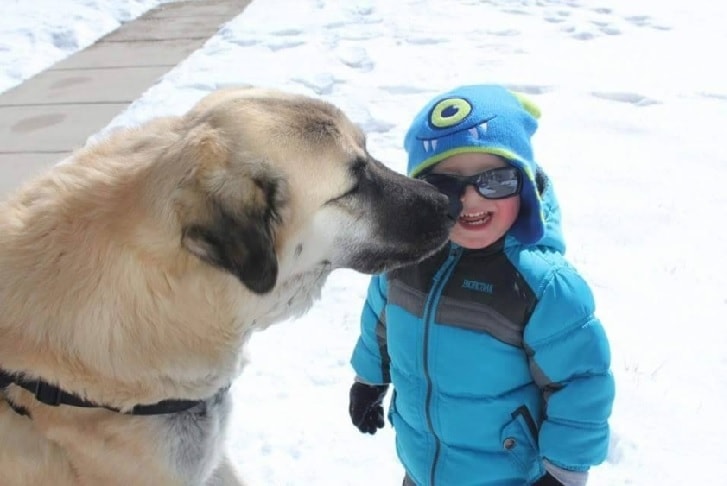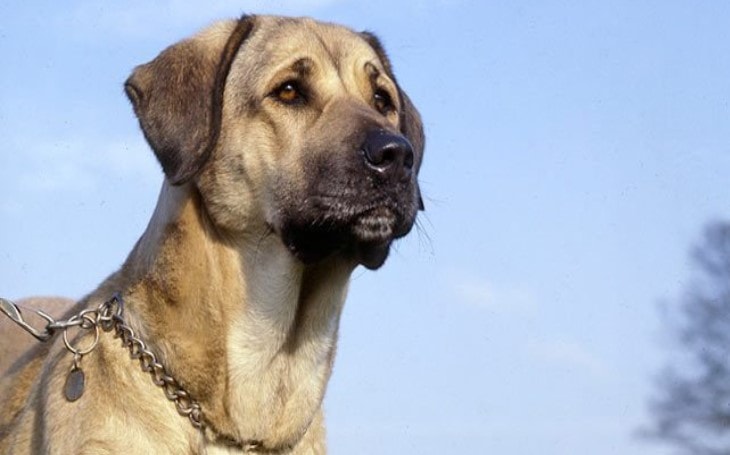Anatolian (Kangal) Shepherd Dog Breed Information
General Information
| Dog Name | Anatolian Shepherd Dog |
|---|---|
| Other Names | Kangal |
| Scientific Name | Canis lupus familiaris |
| Breed Type | Shepherd |
| Group | Working |
| Extinct | No |
| Country of Origin | Turkey |
Physical And Size
| Min Life Span | 11 |
|---|---|
| Max Life Span | 13 |
| Min Ideal Weight for male | 50 |
| Max Ideal Weight for male | 54 |
| Min Ideal Weight for female | 41 |
| Max Ideal Weight for male | 54 |
Ranking
| Intelligent Rank | |
|---|---|
| Trainability | |
| Playfulness | |
| Affection Level | |
| Social Needs | |
| Barking | |
| Watchdog Ability | |
| Territorial | |
| Mouthiness | |
| Adaptability |
Characterisitics
| Temperament | Alert, Protective, Independent |
|---|---|
| Prey Drive | No |
| Fighting Dog | No |
Friendliness
| Stranger Friendly | Low |
|---|---|
| Child Friendly | Medium |
| Cat Friendly | Medium |
| Apartment Friendly | Low |
| Senior Citizens Friendly | Low |
| Service Dog | Low |
| Search and Rescue Dog | Low |
| Biting Potential | Medium |
| Country of Origin | Turkey |
| Nicknames and Other Names | Turkish Shepherd Dog, Anatolian Karabash (Anadolulu Karabaş), Kangal, Karabaş (Blackhead), Coban Kopegi, Kham Kepiji, Kara Bas, Scandinavian Nygaard |
| Scientific Name | Canis lupus familiaris |
| Breed Type | Shepherd |
| Group | Working |
| Bred For | To protect livestock |
| Size | Large-sized |
| Recognized By | UKC, AKC, FCI, CKC, ANKC, KC (UK), AKC |
| Life Span | 11-13 years |
| Ideal Weight | 110-150 pounds (male) 80-120 pounds (female) |
| Ideal Height | 29 inches (male) 27 inches (female) |
| Fur Type | Short |
| Common Colors | White, Liver, Fawn, Blue Fawn, Biscuit & Fawn, Brindle, Gray Fawn, Red Fawn |
| Markings | Silver Mask, Black Mask, Brown Mask, Pinto, Dutch Markings, Pinto, Black Mask |
| Availability | Common |
| Achievements | Has appeared in movies like “Friends With Benefits” and “Cats and Dogs” |
| Suitable for Apartments | No |
| Used in World War | No |
| Most Similar To | Kuvasz |
The giant breed, Anatolian Shepherd was originated from Anatolia in Turkey was bred to guard the livestock and is truly a working breed. No fox or burglar would pass through this giant dog.
If you’re thinking of adding this giant breed to your family then there are certain things you need to know about Anatolian Shepherd dog breed. Remember, this breed is totally not for the first time owners.
Origin And History
The history of Anatolian Shepherd date back to 6,000 years. The giants are named after their homeland Anatolia in Turkey where they are still popular and the point of pride. They were crossed between the mastiff and the hound breeds which gave the Anatolians a long legs and aloof character.
Due to their nomadic way of living these dogs had to protect the flocks of sheep and goats and even their shepherds. They had been large enough to stand against the predators and had stay day and night with the flocks to prevent
These dogs were not fed when they pass the puppyhood. They lived by killing small animals and gophers though never injuring their flocks. Anatolian Shepherds were tied with iron collars with long spikes to protect them from assailants. However, you can still find these working dogs with the long spikes iron collar in Turkey.
A U.S naval officer, Robert Ballard, was fascinated with the giant working dogs and formed The Anatolian Shepherd Dog Club of America in 1970 and began breeding in California. However, prior to that the government of Turkey had given the Anatolians to U.S. Department of Agriculture as a gift to experiment them as a guardians of flocks.
Are The Anatolian Shepherd Child Friendly?
The Anatolian Shepherd is very friendly, loving and calm with their family for whom they are very protective. But because of their large size, they are best suited for homes with older children.

They have a leading attitude which makes them the alpha dogs, and are unlikely to respect the younger children as a leader. Every action should be supervised between the dog and the child by a responsible adult.
As with Anatolian Shepherds, you should teach your children how and when to approach your dog. They will surely love your child and even other pets if raised with them from puppy hood, they will accept them as a part of the flocks.
Behavior, Temperament And Personality
The Anatolian Shepherd was bred to protect the livestock. They can quickly develop aggression around strangers and predators. They determine on their own who is a safe visitor and who is not. As flock protectors they drive away all the animals who are not the part of the flock be it a neighbors dog or other animals passing through his territory. It can cause serious injury or even death.
Talking about their temperament, these dog breeds are bold and vigilant. Anatolians will protect their flocks and family till death. A working Anatolian is a happy dog. You need to be confident, firm and consistent during their training. If they sense any lack of leadership in their owner, they will take no time to rise to that position and become dominant and alpha dogs.
Coming to their personality, they are highly intelligent dogs which often makes them hard to train as they become an independent dog. Anatolians are very protective to their family and flocks and very aloof with the strangers. These dogs are excellent watchdogs with a deep and loud bark.
These
Trainability
Anatolian Shepherds are stubborn, independent dogs. It may become hard to train if you’re not a confident leader. They thrive with leaders who can train them with confidence. This breed will take over the house if given little freedom. You may not be able to keep Anatolian away from barking but he can be taught when to stop barking.
Quick Facts About Anatolian Shepherd
- Anatolian Shepherd were used to protect Cheetah in Namibia.
- Because of their double coat shedding heavily, many people have gave them to the rescuing groups.
- Anatolian Shepherd have appeared in movies like, “Friends With Benefits, “Cats and Dogs” and “Kate and Leopold”.
- The Turkish people kept the breed all to themselves. These breed are likely been around thousand of years, but they didn’t exported Anatolians until 20th century.
- Anatolians are not only the flock dogs in Turkey. There are three more flock dogs including Anatolians; Kangal, Kars and Akbash.
Major Health Issues of Anatolian Shepherd
| General Health | Healthy | |
| Common Health Issues | Hypothyroidism, Hip Dysplasia, Obesity, Bloat, Entropion | |
| Hypoallergenic | No | |
| Vaccination Required | Rabies, Canine Coronavirus, Kennel Cough, Canine Distemper, Canine Parvovirus, Leptospirosis, Canine Parainfluenza | |
| Shedding | Minimal | |
| Drooling | No, unless sick | |
| Grooming | Easy and regularly required | |
| Weight Gain Potential | High | |
| Separation Anxiety | Moderate Chance | |
| Allergies | Atopy | |
| Diets and Supplements | 30% Protein 18% Fat Fish oil and Antioxidant supplements |
Hypothyroidism: Hypothyroidism is more likely to be seen in Anatolian Shepherds. It is cause due to the conditions such as epilepsy, alopecia, obesity, lethargy, hyperpigmentation and other skin conditions.
Entropion: Entropion is the inward rolling of eyelids, which affects the lower eyelids of both both eyes. It will cause irritation and impairment of vision. It generally occurs when the Antolians reaches a year old. However, it should be treated before the dog reaches the adulthood.
Anatolian Shepherds have six Color Patterns
- White
- Brindle
- Blue Fawn
- Red Fawn
- Liver
- White and Biscuit
Anatolian Shepherd Puppies
The cost of the Anatolian Shepherd puppies varies from breeders to breeders. It can costs up to anywhere from $1,000 – $5,000.
Which Dog Breeds Are Antolians Similar To?
- Central Asian Shepherd Dog
- Kuvasz
- Caucasian Shepherd Dog
- Great Pyrenees
- Romanian Mioritic Shepherd Dog
So, now that you know everything about the fiercely protective dogs, Anatolian Shepherds, we hope you made a right decision before bringing them home. They are not for the homes which cannot give them enough time and training. If you want an Anatolian, cut your schedule for your new furry giant pet.
Visit Doglime for more information on various dog breeds.
Tags










